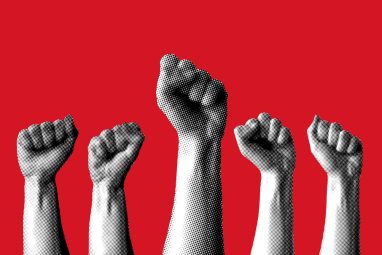How to Become a Better Ally: Three Priorities for Leaders
Many leaders want to be allies and teach their teams to do the same but are confused or overwhelmed by the advice out there. Use this framework to focus on your top goals.
News
- Deloitte and AWS Forge $1 Billion Alliance to Accelerate Digital Transformation in the Middle East
- Over 40% of Agentic AI Projects Expected to Fail by 2027, Report Finds
- Guardian AI Agents Poised to Take 15% of Agentic AI Market by 2030, Gartner Says
- Deloitte Rolls Out Global Agentic Network to Accelerate AI Adoption in the Middle East
- AI Research Forum and Summit Focused on Agentic AI Announced
- Cisco's New Quantum Entanglement Chip Aims to Accelerate Distributed Computing

Nick Purser/Ikon Images
Recent pushback against diversity, equity, and inclusion (DEI) initiatives has caused many leaders to focus on the broader topic of allyship. These leaders want to be better allies and encourage their teams to do the same. In politically charged environments, however, leaders may find the mountain of advice on how to be an effective ally conflicting, confusing, polarizing, or overwhelming to apply. Without a clear decision-making framework, leaders may follow advice that feels right to them in the moment rather than intentionally applying the allyship interventions that would be most effective for their organization’s goals.
Leaders value a diverse workforce because research shows that diversity supports higher employee engagement, employee retention, and stock performance. However, top-down DEI initiatives often lead to pushback. What is missing in many companies is a participatory, empowering, and interpersonal approach to nurturing diversity, inclusion, and belonging through allyship.
But which allyship behaviors and priorities will work best for your organization?
A Three-Part Framework for Allyship
During the past few years, we have conducted several research studies examining the effectiveness of various types of allyship interventions and have assessed the pros and cons of each. Drawing from this work, we constructed a framework for goal-directed allyship.
By applying this three-part framework, leaders can identify specific goals to focus their allyship interventions on, such as effectively addressing transgressions, advancing marginalized employees, and scaling up allyship.
1. Addressing Transgressions
A relatively visible incident of bias is a situation that calls for leaders to immediately intervene, such as when a person makes a sexist comment in a public forum. The most common allyship goal in such an instance is to address the transgression by holding the transgressor accountable and educating them about what behaviors are (un)acceptable in the organization. Past research has shown that direct confrontation by publicly calling out bias can be an effective intervention in reducing similar incidents in the future by the transgressor as well as the onlookers.
However, our research has shown that while confrontation is certainly better than inaction, three unintended negative consequences can occur. First, the callout increases some onlookers’ victim-blaming, possibly doing more harm than good for the very people the ally is striving to support. Second, it can increase onlookers’ sympathy for the transgressor, possibly nudging some of them toward less-explicit forms of bias. Third, it also increases some individuals’ hostility toward the ally, wherein the ally is seen as overreacting. Taken together, calling someone out is likely to seed polarization and tension within the organization — and possibly worsen the situation for the victim.
Some leaders take a different approach to holding a transgressor accountable and educating them: They speak up against a biased comment or behavior in a meeting by reminding the transgressor that their behavior is unacceptable according to the organization’s antidiscrimination policy. Our research has found that while this sort of less confrontational intervention does not satisfy some onlookers’ desire for justice and might even be seen as insincere, it is nevertheless associated with lesser victim-blaming and might be more beneficial for marginalized employees than calling out bias.
2. Advancing Marginalized Employees
Many leaders believe that the most important, overarching goal of allyship work is to support marginalized employees in having successful careers, which in turn enables their organization to increase equity. However, leaders often approach the career advancement of these employees through initiatives targeted at improving their skills. This not only puts the onus on people in marginalized groups to “keep trying harder” but also often proves to be inadequate. The biased perceptions of other colleagues (such as evaluators) regarding the skills of marginalized employees must also be challenged and changed so that people are not devalued because of their identities.
To this end, our research shows that highlighting the strengths of marginalized employees is a useful allyship intervention. In preparation, leaders must first familiarize themselves with the types of biases (such as stereotypes about someone’s appearance or accent) that may cause people to devalue the talents and achievements of their marginalized employees. Next, leaders must familiarize themselves with the talents, skills, achievements, and efforts of those employees.
Armed with this knowledge, when a bias incident occurs, leaders can pivot the conversation to highlight the talents and strengths of marginalized employees. For instance, if a colleague makes a disparaging remark about an employee’s accent, the leader-ally can pivot and highlight their strengths by responding, “Oh, we are so lucky to have her! She really goes the extra mile to show how our work serves clients’ needs. On the last project, she spent hours learning about the needs of a prospective client even before the first meeting. They were so impressed, they hired us right away.”
When marginalized employees are targets of bias, leaders can highlight strengths to redirect attention to accomplishments, affirming and boosting them. In addition, if a leader anticipates future bias, regularly highlighting the person’s strengths across various situations can also potentially prevent biased behaviors.
An advantage of highlighting strengths in response to discrimination is that it improves perceptions of the ally as well as the marginalized employee. On the downside, because this intervention does not label the bias or unpack the assumptions behind the it, this approach does not explicitly educate current and future transgressors on what not to do or say.
3. Scaling Up Allyship
Recent research has found that people are more compassionate today than they were even a decade ago. This offers much hope for scaling up allyship awareness and behaviors. However, although a vast majority of people say that they want to be allies, they hesitate to act. Our recent study points to why people find acting as an ally to be so challenging: The same allyship behavior can draw polarized responses from onlookers. Some people think that the ally is overreacting, whereas others think that they’re not doing enough. Furthermore, when allies publicly receive backlash, it can further stymie onlookers from becoming allies in the future. How people perceive different allyship interventions is a relevant consideration for a leader.
At a systemic level, recent top-down approaches to instituting DEI policies and mandatory training programs have drawn backlash. At the same time, in surveys we conducted, more than 75% of working adults in the U.S. and Canada, regardless of their professional level or experience, said that they intend to support equity. This paradox suggests that perhaps a different approach is called for: creating a culture of allyship in which employees at all hierarchical levels who want to be allies have a clear vision of how they can meaningfully contribute to an equitable workplace.
So, overall, an important long-term goal for a leader is to scale up one-off allyship and create an organizational culture in which allyship becomes the norm. How can you pursue this? Leaders should strive to take these actions:
- Make allyship less interpersonally risky.
- Normalize allyship actions.
- Help a broader contingent of employees develop skills in allyship interventions.
- Model a variety of allyship behaviors, in appropriate doses.
Your choices should fit the organizational culture and be done in ways that onlookers see as both aspirational and achievable. To be sure, your actions also need to be done in a way that does not undermine marginalized groups and does not perpetuate performative allyship.
Depending on your organization’s situation and goals, any one of these three paths may be particularly urgent or less important right now. By consciously considering and prioritizing among the three, leaders can empower and equip people at all levels to choose the right interventions that will help make a difference within multiple circles of influence.
Now, it is up to you to get started.





